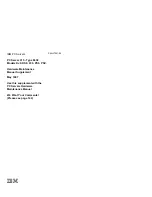
Option
Description
Enables you to control the reporting mode of the TPM. The
TPM Security
option is set to
Off
by default. You
can only modify the TPM Status, TPM Activation, and Intel TXT fields if the
TPM Status
field is set to either
On
with Pre-boot Measurements
or
On without Pre-boot Measurements
.
TPM Information
Changes the operational state of the TPM. This option is set to
No Change
by default.
TPM Status
Specifies the TPM status.
TPM Command
CAUTION:
Clearing the TPM results in the loss of all keys in the TPM. The loss of TPM keys may
affect booting to the operating system.
Clears all the contents of the TPM. The
TPM Clear
option is set to
No
by default.
Intel TXT
Enables or disables the Intel Trusted Execution Technology (TXT) option. To enable the
Intel TXT
option,
virtualization technology and TPM Security must be enabled with Pre-boot measurements. This option is set to
Off
by default.
Power Button
Enables or disables the power button on the front of the system. This option is set to
Enabled
by default.
NMI Button
Enables or disables the NMI button on the front of the system. This option is set to
Disabled
by default.
AC Power
Recovery
Sets how the system behaves after AC power is restored to the system. This option is set to
Last
by default.
AC Power
Recovery Delay
Sets the time delay for the system to power up after AC power is restored to the system. This option is set to
Immediate
by default.
User Defined
Delay (60s to
240s)
Sets the
User Defined Delay
option when the
User Defined
option for
AC Power Recovery Delay
is selected.
UEFI Variable
Access
Provides varying degrees of securing UEFI variables. When set to
Standard
(the default), UEFI variables are
accessible in the operating system per the UEFI specification. When set to
Controlled
, selected UEFI variables
are protected in the environment and new UEFI boot entries are forced to be at the end of the current boot
order.
Secure Boot
Policy
When Secure Boot policy is set to
Standard
, the BIOS uses the system manufacturer’s key and certificates to
authenticate pre-boot images. When Secure Boot policy is set to
Custom
, the BIOS uses the user-defined key
and certificates. Secure Boot policy is set to
Standard
by default.
Secure Boot
Policy Summary
Specifies the list of certificates and hashes that secure boot uses to authenticate images.
Secure Boot Custom Policy Settings screen details
Secure Boot Custom Policy Settings is displayed only when the
Secure Boot Policy
option is set to
Custom
.
About this task
To view the
Secure Boot Custom Policy Settings
screen, click
System Setup Main Menu
>
System BIOS
>
System Security
>
Secure Boot Custom Policy Settings
.
The
Secure Boot Custom Policy Settings
screen details are explained as follows:
Option
Description
Platform Key
Imports, exports, deletes, or restores the platform key (PK).
Key Exchange Key
Database
Enables you to import, export, delete, or restore entries in the Key Exchange Key (KEK) Database.
Authorized
Signature
Database
Imports, exports, deletes, or restores entries in the Authorized Signature Database (db).
Forbidden
Signature
Database
Imports, exports, deletes, or restores entries in the Forbidden Signature Database (dbx).
Pre-operating system management applications
45
Содержание E35S001
Страница 2: ......
Страница 164: ...164 Getting help ...
















































